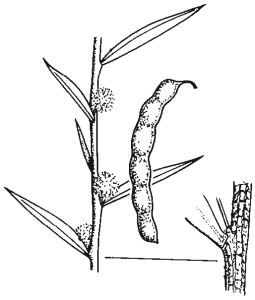Family:
Fabaceae
Acacia siculiformis
Dagger Wattle
Other Names:

Name Origin:
siculiformis — from Latin sicula, small dagger, and formis, resembling, referring to dagger-like ‘leaves’.
Regional Subspecies:
Occurrence:
Regional:
Noted in the hills of the areas: Rosewood Plateau; Ournie; Paddy’s River-Burra Valley; Tooma and Bringenbrong-Khancoban.
Australia:
NSW, Vic, Tas.
Habitat:
Eucalypt woodland and dry sclerophyll forest, often on granite-derived soils. Common near streams.
Habit:
Spreading to erect shrub 50 cm to 3 m high with rigid ‘leaves’ 1-3 cm long.
Site Preference:
Well-drained rocky or sandy sites. Tolerates frost and snow. Very hardy.
Flowering:
Golden-yellow or pale-yellow to more or less white, Aug-Nov.
Seed Collection:
Early Dec to late Feb.
Propagation:
From scarified seed. Pour boiling water over seeds and soak for several hours before drying and sowing.
Regeneration:
From seed, particularly after fire.
VALUES:
Shade & Shelter:
Useful low-level cover in windbreaks.
Land Protection:
Useful in controlling erosion, due to soil-binding fibrous roots. Legume — improves soil fertility by ‘fixing’ nitrogen.
Wildlife:
Prickly foliage good refuge for small birds. Flowers are a pollen source for native moths, butterflies and other insects. Insect-eating birds attracted. Nectar an important food for native insects and birds. Seed source for parrots and native pigeons.
Ornamental:
Attractive for low maintenance areas in cool regions.
